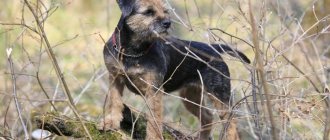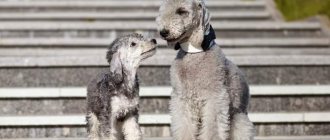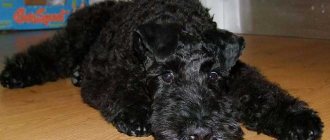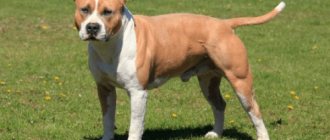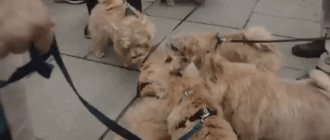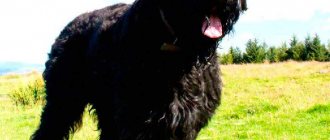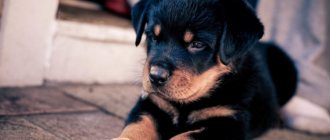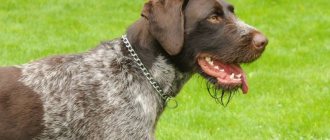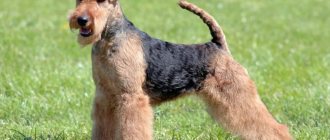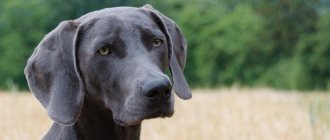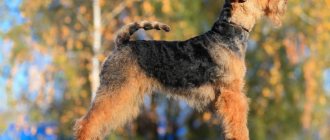The Russian Toy Terrier dog breed has gained particular popularity in Russia. The dog is small, but this does not affect its quality as a guard. She is a completely fearless animal that can always warn her owner about danger and come to his defense.
This breed of small dogs seems to be a faithful friend of its owner and a kind of family member. Even if you don’t see the dog in person, from the photo the Russian Toy Terrier evokes only positive emotions.
The breed is so unpretentious that it does not even require special care. Due to the small size of the dog, it is usually considered a “pocket” dog, but it is worth dispelling all the myths.
After all, it is not uncommon for the Toy Terrier to serve as a guard along with larger breeds. Developed hearing helps her hear even the slightest rustle of an approaching object, and a strong voice, like a bell, can help the owner orient himself and react in time.
Description of pets
Toy terriers are miniature dogs with a cheerful disposition, love of life and activity.
Exterior
(information in accordance with the breed standard ): :
- eyes - large, slightly convex, round in shape, set wide apart;
- ears - large, erect, high-set, triangular in shape;
- body - strong back, oval chest, slightly sloping, rounded croup;
- limbs are straight, slender, the hind limbs are set wider than the front ones.
Representatives of this breed move quickly, straightforwardly, freely.
Photo and video review
The popularity of different types of pets changes over the years. The majority appreciated the advantages of small representatives of the toy terriers. Dogs do not require much space and can be taken with you on trips. By the way, a Russian toy will not cause outrage in a hotel or plane.”
Origin story
The ancestors of the breed were English toy terriers , bred in the 19th century. in England by selecting small black and tan hunting terriers and then crossing them with small greyhounds .
Their main purpose was to catch rodents and insects, in which they are somewhat similar to the Prague rat rats, and to entertain children. The name "Toy Terrier" was given to these dogs in the second half of the 20th century.
Russian toy terriers
appeared in the 20th century. in the USSR, when the process of restoring the breed was underway .
Due to the lack of purebred individuals, crossbreds were also taken into work. The resulting puppies were significantly different from their parents, so in 2006 they were officially identified as a separate breed. At first these were only smooth-haired toy terriers, and later long-haired ones also appeared.
American toys
also differ significantly from English ones . When breeding them, they used fox terriers, from which the “Americans” got the white color of the main part of the body and character.
Mating
Toys are easier to breed than large dogs. They don’t need a long introduction, a long walk, or a lot of free space. But to untie the dogs, it is still recommended to invite a trained person who will tell you how to properly help the animals.
Puberty comes to these dogs early: at 8-10 months, the bitch begins her first heat, and males mount soft toys or furniture. This habit needs to be weaned off gently, but you should not scold your pet so as not to disturb its psyche. Otherwise, adult Toy simply will not want to mount a girl.
Toy terriers can be untied at 20-25 months, when their bodies are able to conceive and bear offspring. At this time, the girl should go into her third heat. The most favorable time is 13-15 days from the beginning, when light discharge appears, the loop loosens, and the bitch’s behavior changes to playful.
If the dogs are breeding dogs and have status, then they need to be bred through a kennel. Owners must fill out certain forms and obtain a certificate. The male is selected in advance, the owners set a date and determine the price. It is usually equal to one puppy or a percentage of its value, depending on the number of heads in the litter. If the bitch is empty, mating is not paid.
The girl is brought into the territory of the male dog, where he will feel relaxed. When the boy makes the cage, the animals need to be helped: hold them so that they do not lose their balance, guide the male into the loop. Sexual intercourse lasts 10-15 minutes . Even in the absence of a castle, the female can be plump. Mating is repeated after 2 days .
Read a detailed article on the topic: “Everything you need to know about breeding dogs: appropriate age, what to do if it doesn’t work out, rules and tips.”
Character traits
Toy terriers are cheerful, sociable and playful dogs . They are distinguished by cheerfulness and energy, they quickly become the center of attention and a source of positivity.
Friendly Toy Terriers get along well with other pets as long as they do not show aggression, and they easily get along with children due to their curiosity and love of games.
However, it is better not to buy a dog of this breed for families with children under 5-6 years old, as they can accidentally injure the pet during play.
Toys are infinitely devoted to their owner, they need their attention and care . Dogs have difficulty withstanding loneliness, which becomes a source of stress and a cause of aggressive behavior.
Toy terriers are fearless guards, unaware of their own compact size, capable of bravely rushing into a fight even with much larger dogs if they feel that their owner is in danger.
Expert opinion
Kozhevin Semyon Kirillovich
Expert dog handler.
Many people love toy terriers precisely for their miniature size, but at the same time this is also a minus of the breed, since dogs, especially puppies, are very susceptible to injury. Also, most owners note the friendliness and lack of aggression in toy dogs, but it is worth noting that this is only possible with proper upbringing. In general, this breed is suitable for almost everyone, even those who have not dealt with dogs before. The only exceptions are people who lead a measured lifestyle - the irrepressible energy of the toy is not combined with calmness, constant silence and monotony.
Advantages
The advantages of the breed include:
- Kindness, lack of aggression, cuteness;
- Good mental abilities and learning ability;
- They behave wonderfully when traveling and can easily tolerate changes in environment;
- Devotion to the family, boundless love for the owner, affection;
- Good security qualities, despite its size;
- Compact, convenient, undemanding in content.
Flaws
There are no bad dogs, only ill-mannered ones. The character of a pet depends on several factors: heredity, manners instilled by the owner, psychological trauma. The chance of getting a healthy, balanced pet is much higher if the purchase is made at a nursery.
Most individuals have the following disadvantages:
- Mental instability, attacks of aggression and anger;
- Dislike for children, strangers, animals;
- Selfishness, jealous attitude towards personal objects and owners;
- Destructiveness (gnaw, scratch, drag everything they see)
- Fragility, pain, difficult childbirth.
Advantages and disadvantages
Toy terriers are small dogs, ideal for living in city, even small, apartments.
In addition, they have a number of other advantages:
- courage;
- mind;
- loyalty;
- good health;
- the ability to train to a tray or diaper;
- pretty appearance;
- friendliness;
- unpretentiousness.
Along with their advantages, toy terriers also have some disadvantages.:
- stubbornness;
- loud barking;
- aggression and uncontrollable behavior due to improper upbringing;
- large tremors when overexcited;
- intolerance of loneliness;
- tendency to allergies;
- fragile skeleton.
Also, representatives of this breed are sensitive to temperature changes and cannot tolerate cold.
Selection rules
By purchasing an animal, a person takes on a friend for many years. Therefore, it is important to know what kind of toy terrier puppies should be. What you need to pay attention to:
- baby's behavior;
- parents;
- conditions of keeping the bitch and her litter;
- to the breeder.
A toy terrier puppy should give the impression of being a nimble animal and not differ from the rest of the litter. The coat is smooth, shiny, without defects, clean eyes and teeth.
It’s good if you have the opportunity to observe the parents of the toy terrier puppy. Most likely, he will turn out to be similar to them. If a dog's mother or father is aggressive, the offspring may become the same.
It is important to see in what conditions animals grow, mature, and their nutrition. You need to decide in advance who to choose, a girl or a boy. Determine the age of the toy terrier.
A good breeder will easily answer questions about the development of the puppy after birth, give advice, addresses of good veterinary clinics, and recommend food for the pet.
Expert opinion
Anna Abramenko
An avid dog lover. Experience in veterinary medicine since 2009.
Ask a Question
An animal is not a toy that can be changed. In order not to get confused and not be led by chance, it is better to create a table of signs that will help when buying a dog.
Main types
The table shows the main varieties of toy terriers and their descriptions:
| View | Description |
| Russian toy terrier | The breed was recognized by the FCI in 2006. Modern Moscow Toys are small, long-legged dogs with a small apple-shaped head, a dry, elongated muzzle, large bulging eyes, high-set triangular ears and a high-set tail. Height at the withers is 20-26 cm, weight 2-3 kg. There are 2 varieties: long-haired and smooth-haired |
| English toy terrier | Elegant dogs, 25-30 cm tall and weighing 2.7-3.6 kg. They have a narrow muzzle, an elongated skull, and erect ears. The coat is thick, short, and fits tightly to the body. Only black and tan color allowed |
| American Toy Terrier | A breed still unrecognized by the FCI. When breeding, they used smooth fox terriers, English toy terriers and Chihuahuas. The height of these dogs is 24-25 cm, weight - 1.5-3.5 kg. They have a small head, large triangular erect ears, a short tail and a shiny coat, colored in 2 or 3 colors: white with black and (or) red spots on the head and rump |
History of the Russian Toy Terrier breed
Smooth-haired Russian Toy Terrier
The ancestors of Russian Toys were English Toy Terriers, who gained fame as incomparable rat catchers. The first representatives of this venerable family appeared in Russia back in the era of Peter the Great, and by the middle of the 19th century, small but extremely playful dogs turned into the favorite pets of the domestic elite. Toy terriers lived in imperial residences, guarded the chambers of wealthy landowners, traveling to balls and social events with their arrogant mistresses.
With the advent of Soviet power, decorative dogs migrated to the category of “bourgeois excesses”. The new government gave preference to more useful breeds aimed at full-fledged service and protection, so for almost half a century, toy terriers remained in the shadows, gradually dying out and degenerating.
In the 50s, Soviet cynologist enthusiasts decided to revive the tribe of legendary salon dogs. But since there were no purebred representatives of the toy terrier family left in the USSR by that time, specialists had to work with animals without pedigrees and individuals taken by Soviet soldiers from Germany as war trophies. An additional difficulty was that the offspring obtained during the experiment could not be compared with the cubs of English terriers due to the Iron Curtain policy. As a result, domestic experts did not suspect for a long time that they had bred a new breed, significantly different from the one they were initially targeting. For example, toy terriers of the Soviet “spill” were one and a half times smaller than their British counterparts, had different body proportions and skull shape.
Longhaired Russian Toy Terrier
However, the discoveries did not end there. In 1957, in a family of Russian Toys, where one of the parents was not purebred, a male puppy was born with long feathering of fur in the area of the ears and paws. The animal looked so cute and funny that the breeders decided to keep this attractive mutation, leaving the puppy for the breed. This is how an independent branch of the breed appeared - the Moscow Longhaired Toy Terrier.
Despite their sharply increased popularity, Russian Toy Terriers remained “local” pets for quite a long time, practically unknown outside the country. And only in 2006, the International Canine Association, reluctantly and with reservations, recognized salon dogs as an independent breed. At the request of the FCI commission, Russian Toy Terriers were renamed Russian Toys and received the right to participate in world and European championships.
An interesting fact: among the famous owners of these “toy” dogs are Alla Pugacheva, Garik Kharlamov, Sergey Lazarev, Christina Aguilera and Diana Gurtskaya.
Color variations
There are several coat color options for Toy Terriers.:
- black and tan - the black color should not have any shades, the tan is on the face, ears, chest and near the temples;
- sable - toi with red hairs at the roots and black at the ends;
- chocolate, brown and red - most often found in Russian Toy Terriers, these colors are difficult to preserve in offspring;
- blue and purple - arise as a result of the activity of a recessive gene;
- fawn - acceptable options are from light red to milky white;
- isabella - a color derived from lilac, rare;
- white - such dogs are attractive in appearance, but cannot participate in exhibitions and breeding.
The variety of colors is explained by the fact that 2 pigments and 10 genes are involved in their formation.
Types by coat type (example in photographs)
There are differences between smooth-haired and long-haired toy terriers.:
- Smooth coats have no undercoat. Their fur coat is the same length all over their body. Such dogs have a hard time in the cold season, which is why it is recommended to buy special clothes for them.
- Long-haired dogs also do not have undercoat, but the length of the fur coat varies along the body. There are fringes on the ears and elbows. Also, the hair is elongated throughout the body, and especially in the tail area, on the chest and sometimes on the cheekbones.
Animal nutrition
Toy terriers can be fed with ready-made dry food or natural products, the main thing is to keep the diet balanced and not mix both types of feeding.
A natural menu should contain:
- lean meat;
- buckwheat, oatmeal, rice porridge;
- vegetables and fruits;
- low-fat cottage cheese, kefir;
- sea fish;
- boiled egg yolk.
You cannot feed a toy terrier :
- fatty and smoked products;
- sweets and pickles;
- sausages and flour products;
- river fish;
- potatoes, legumes.
Among dry food, preference should be given to premium or super premium products, which contain all the necessary micro- and macroelements.
The most popular foods are products from the brands Acana, Orijen, Canidae, Hills, Eukanuba, Purina, Royal Canin.
How does it develop day by day in the first month?
| Days | Physical development and behavior change |
| 1-4 | The puppy cannot see or hear, he has no fat layer, and thermoregulation is undeveloped. During this period, the puppy produces meconium (original feces). |
| 5 | Pain sensitivity is reduced, the brain is poorly developed. |
| 6-8 | The nose becomes stained, reflexive chills appear, and active weight gain occurs. |
| 8-9 | The original weight is doubled. |
| 10-15 | The puppy's eyes begin to open, the pupil reacts to light, but the retina is poorly developed. |
| 16-18 | A fat layer begins to form, thermoregulation improves, and the puppy gradually learns to cope without additional sources of heating. |
| 19-21 | The toy terrier baby begins to hear and reacts to sound. |
| 22 | Baby teeth begin to emerge. |
| 23-24 | The sucking reflex fades, interest in solid food appears. The puppy already knows how to bite, chew, and is actively exploring the world. |
| 25-30 | Thermoregulation is fully formed, the body temperature is like that of an adult, the baby is already responding to its name, and motor activity is increasing. |
Health and life expectancy
Most Toy Terrier diseases are hereditary or result from improper care.
Most often these dogs are diagnosed:
- fractures and dislocations;
- vertebral displacement;
- dental problems - stones, plaque, disruption of the replacement of milk teeth by molars;
- conjunctivitis;
- glaucoma;
- cataract;
- retinal atrophy;
- otitis;
- increased intracranial pressure;
- breathing problems;
- diarrhea;
- vomiting;
- hydrocephalus;
- epilepsy;
- diseases of the cardiovascular system;
- diabetes;
- obesity;
- allergies;
- hind leg failure.
To prevent diseases, it is necessary to follow a diet and monitor its balance and nutritional value, carry out deworming and treatment for external parasites, and regularly undergo routine examinations by a veterinarian.
With proper care and proper living conditions, the life expectancy of toy terriers is on average 12-15 years .
Diseases
It is important to immediately point out an interesting detail: if you pay attention to the dog’s needs and care for him properly, he will almost never be sick. The most vulnerable areas of a toy terrier are the eyes, bones and teeth. At about six months, the dog loses its milk teeth, which are replaced with molars.
But the difficulty may be that the milk ones will turn out to be “lazy” and will not fall out on their own. And the indigenous people, meanwhile, will make their way. Thus, there is a risk of the formation of so-called “double” teeth. In this case, surgical intervention will be required.
The Toy Terrier is an intelligent and loyal breed of dog.
These miniature four-legged comrades also suffer from such a scourge as tartar. This nuisance, by the way, is common to all breeds with a height of less than 35 cm. Tartar provokes tooth loss, so caring for them must begin with young claws.
In addition, you should pay close attention to the dog’s physical activity. This fragile little girl has a very high risk of developing a fracture or dislocation of her knee, so it is important that the dog does not jump from a height that exceeds his own height. When in contact with other dogs, a toy terrier can unexpectedly show its fighting spirit, which is fraught with not the most rosy consequences.
In this case, you should be on your guard in advance. Typical eye diseases in this breed include retinal atrophy in old age and cataracts. Both cases require medical, if not surgical, intervention. Finally, it is worth noting that the dog is prone to colds. We are not talking about the owners wrapping up their pets, but it still makes sense to dress them warmly in cold weather.
Dimensions and weight
A standard representative of the breed weighs about 1 kg at 2.5 months, and approximately 1.5 kg at 3-4 months. An adult dog grows to 20-27 cm at the withers and reaches a maximum weight of 3 kg.
Read more detailed information about the size of toy terriers here.
NOTE!
Mini Toy Terriers weigh about 600-800 g at 2-3 months and 1.5-1.6 kg when full grown.
Miniature representatives of the breed more often have pathologies and developmental defects.
Price range
The cost of a purebred toy terrier puppy , depending on the region in which the puppies are sold, as well as their pedigree and quality, can range from 20 to 85-90 thousand rubles .
Puppies with obvious defects in the exterior, which are sold exclusively as pets, are slightly cheaper.
Education and training
Without proper education and training, toy terriers grow up to be uncontrollable dogs that consider themselves to be the main ones in the family.
These dogs are smart and have a good memory, so instill in them the rules of behavior in the house and teach them the basic commands “Fu!”, “Come to me!”, “Sit!” not difficult .
You need to start training from early childhood, immediately after the puppy remembers its name.
Toy terriers are cunning and constantly try to avoid following commands, so it is necessary to develop rules and stick to them.
Classes should be regular, commands should be given in a calm but confident tone, the owner needs patience and perseverance. You cannot physically punish your pet .
Key points in training
Since this breed is decorative, their representatives are usually not trained. They have enough knowledge of basic commands, but the skill of executing them must be honed to perfection. Russian Toys are rarely obedient and flexible, but with proper upbringing they can be taught basic techniques:
- "Sit";
- "Voice";
- "Near";
- "Place".
Raising puppies begins from the first months of life. To prevent the dog from becoming the head of the family, you must not allow him to manipulate people.
You cannot feed from the master's table, teach him to sleep and jump on the master's furniture, or enter the house before other family members.
The owner needs to be persistent, strict, but not rude. They are vindictive and fragile; a slight blow can disrupt their nervous system.
Read about how to properly train a dog in the article: “Training a puppy: effective methods from dog handlers, learning commands at home.”
Dog care
The table contains the main points for caring for toy terriers :
| Part of the body | Care |
| Wool | Short-haired toy terriers should be combed every 7-14 days, more often during the shedding period; Long-haired representatives of the breed need to be combed daily, and they also need to have their coat trimmed periodically. Washing is required once a quarter using shampoo appropriate for the coat type. |
| Eyes | Wipe daily with a cotton pad soaked in warm water or chamomile infusion. |
| Teeth | Clean every 7 days with a special paste and brush |
| Ears | Inspect regularly and clean monthly |
| Claws | Once a month you need to trim with a nail clipper and file to avoid delamination. |
Care and maintenance
These dogs are absolutely not allowed to live on the street. Not only because of its size, but also because of its instability to sudden weather changes. Apartment housing is suitable for them, even without walking (with a home toilet).
There are no special rules for the care and maintenance of these dogs. Like all decorative breeds, they do not require large amounts of feed. They don’t even always need a lounger, because they usually sleep next to their owner.
Before buying a dog, you will still have to purchase some items for daily use: bowls on stands, a leash and collar (or harness), litter tray, toys, hygiene products.
Nutrition
The good thing about keeping a small dog is that it doesn't require a lot of food. An adult Toy will need up to 300 grams of food diluted with water or broth per day. Therefore, many dog breeders choose dry foods. They are easy to use and do not require refrigeration, cooking or wasting extra time. These dogs will benefit from holistic (grain-free) super-premium food for small breeds.
You need to carefully choose the product to eliminate possible digestive problems. Low-quality food contains elements that can harm your pet. Therefore, it is important to read the composition, find out the opinions of breeders and dog breeders on forums.
Adult pets are fed twice a day: morning and evening. A puppy needs 4-5 meals a day until 3 months, 3 meals a day until 6-7 months, then you can switch to adult feeding.
Large pieces for chewing can be given from 3-4 months. In summer, the serving size is reduced, and in winter it is increased.
Natural food is familiar to dogs; it is considered correct and healthy, although it does not contain all the necessary microelements, like dry food. Therefore, animals are additionally fed with vitamins.
The diet should consist of 50% proteins:
- Lean meat;
- Eggs;
- Boiled sea fish without bones;
- Kefir;
- Cottage cheese.
Another 30-40% is given to cereals: cereals boiled in broth or water. The rest of the space is occupied by vegetables and fruits.
The following products are strictly not permitted:
- Bones;
- Pork;
- Butter;
- Legumes and potatoes;
- Citrus;
- Floury and sweet;
- Fried, smoked and fatty.
It is also prohibited to feed the dog from the table, and all attempts at begging are suppressed . You can pick up treats at a pet store or use low-fat varieties of cheese. It is not recommended to mix dry and natural food.
You must follow a drinking regime. The bowl of water should always be full, especially in the summer when food portions are reduced. If the puppy does not drink, he should be given water from a syringe or pipette, gradually teaching him to drink on his own.
We recommend that you read a detailed article on the topic: “How and what to feed a dog: types and characteristics of nutrition.”
Health
These dogs are quite sickly, but live a long life of 15-20 years with proper care. Problems occur due to poor heredity and illiterate care.
In addition, they are fragile and can be injured from a minor bruise or falling from a low sofa.
It is important to vaccinate the animal on time, take it to a veterinary clinic for examination, and monitor its condition, color of discharge, and appetite.
Vaccinations
Even small indoor pets that do not walk outside and do not have contact with other animals need vaccination. A person carries a huge amount of bacteria and viruses on himself, his clothes and household items, so a dog can become infected without even leaving the house.
Vaccination does not provide 100% protection against infection, but it prevents dangerous diseases and helps to cure them faster. Unvaccinated animals are not able to overcome the virus and, most often, die in the early stages.
The vaccination calendar is especially busy in the first year of a puppy’s life. Because during this period the animal is especially vulnerable without the mother’s immunity. Primary vaccination is usually carried out in the nursery.
But the owner must be informed about the timing of further procedures:
- Complex vaccination is carried out at 2, 2.5, 6, 12 months and requires annual renewal;
- Rabies vaccination is carried out at 7 months and also requires annual renewal.
In addition to the protective function of vaccination, they also have a registration function. All procedures are recorded in the dog’s veterinary passport. Without basic vaccinations, an animal cannot be transported across the border. A prerequisite is that vaccination must be done in the last 12 months, but no later than 20 days before transportation. Also, the pet must be taken to the veterinarian in advance for examination.
Important article on the topic: “Everything you need to know about dog vaccinations.”
Diseases
Toy terriers are small and fragile, and they often have health problems. Diseases can be transmitted from parents, or can develop due to improper care or stress. Problems specific to the breed:
- Dislocations, fractures, sprains, concussions, necrosis of the femoral head;
- Allergies, digestive problems, bloating, pancreatitis;
- Cataracts, retinal atrophy, conjunctivitis;
- Decreased blood sugar, epilepsy, seizures.
Walk
Walking is not mandatory for these pets. They don't have to burn off energy during hard workouts, and they can go to the toilet in their indoor litter box. But, as with all dogs, interaction with the environment is the best way to spend time. Toys can be walked 2 times a day for 30-40 minutes.
Puppies begin to be walked at 3 months, after the second vaccination. First, they are carried out in their arms, after 3-4 days they are lowered to the ground and accustomed to a leash. For the first two weeks, it is better to choose quiet places for a walk; as you socialize, you can experiment with noisy highways and avenues.
Toy terriers are not friendly. They do not particularly like other animals, strangers, or children. But with proper upbringing, these dogs have normal contact with others.
These dogs do not have an undercoat, so they freeze in cold weather and overheat in warm weather. In frosty, dirty or cool weather, animals wear insulated protective overalls. In summer you need to avoid sun rays.
Grooming
These dogs practically do not shed. Short-haired cats do not require regular brushing at all, although dead hairs need to be removed periodically. Long-haired pets are brushed 3-5 times a week with a long-toothed brush. They are bathed every 2-3 weeks, and their smooth-haired counterparts once a month.
It is important to monitor the condition of your teeth. Due to their picky eating habits, Toys do not brush their teeth with large pieces or hard foods, and they also do not like special chewy treats.
Therefore, brushing your teeth is an important monthly procedure that prevents the appearance of tartar and other problems with the oral cavity.
The eyes and ears are examined regularly to check for inflammation. Claws are trimmed with special pliers once a month. After walks, be sure to wash your paws under warm water. If the pads become rough or crack, they are lubricated with baby cream.
In the summer, be sure to treat your pet for fleas and ticks. This can be done using special solutions, powders or shampoos; collars are also sold. We must not forget about deworming - cleansing of worms. It is carried out once every 2 months.
Breeding principles
There are several factors to consider before breeding a Toy Terrier.:
- dog class - representatives of the pet class cannot participate in breeding;
- size - for dogs below 20 cm and weighing less than 1.5 kg, pregnancy and childbirth are dangerous;
- coat length—short-haired Toys cannot be crossed with long-haired Toys.
CAREFULLY!
The wrong choice of partners leads to the birth of a litter with various pathologies.
Before the first mating, the bitch must go through at least 3 heats. Most often, 1 to 3 puppies are born in a litter.
If the Toy owner does not plan to breed his dog, then perhaps he should think about sterilization. This will help avoid some of the inconveniences associated with estrus or hunting for females.
When do puppies' teeth change?
In Toy Terrier puppies, teething begins to change at 4–6 months, and by the age of one year, all of the dog’s milk teeth fall out. The owner can speed up this process if he manually loosens the teeth every day.
As a rule, incisors change at five months, canines change at 5–7 months, premolars at 4–6 months, and molars at 4–7 months.
This period in a dog’s life puts quite a lot of stress on the body. Milk teeth with large roots may not fall out for quite a long time, causing significant discomfort to the animal. At this time, the dog may be lethargic, have no appetite , and even the ears, which are already confidently erect, may droop again.
Important: Poor dental care can lead to the development of malocclusion. Dogs with such a defect face disqualification from the exhibition if it is a show class dog.
It is possible to remove baby teeth in a clinic, but there are a number of disadvantages. If the operation was performed under general anesthesia, it may take a long time for the dog to recover from it; subsequently, such methods of anesthesia cause harm to the dog’s body.
When a dog's teeth are forming, under no circumstances should the puppy be given hard objects or bones to chew on, or allowed to play with sticks, and it is also not recommended to vaccinate the puppy until the process is completed.
The main thing to remember is that the pet’s health will depend entirely on the owner. An animal that is surrounded by attention and care will always look great. And most importantly, in return you will receive a devoted friend!
Nicknames for boys and girls
Nicknames given to purebred dogs in kennels in accordance with the rules of the RKF are most often long and difficult to pronounce, so owners give their pets other, “home” names . What it will be like depends only on the owner’s imagination.
| Floor | Nickname |
| Male | Male Adam, Alf, Archie, Barney, Bruno, Wally, Hector, Darcy, Sunset, Casper, Conti, Lord, Max, Nikki, Nor, Oscar, Pierce, Rally, Sapphire, Torrey, Fant, Harvey, Chuck, Charlie, Chance , Elton, Janis, Nolik, Baby, Funtik |
| Bitch | Bitch Iris, Agness, Aika, Bunny, Bessie, Beta, Vivien, Gabi, Gerda, Daina, Dakota, Daphne, Debbie, Dolly, Eva, Jasmine, Zarya, Zateya, Zlata, Country, Karin, Maggie, Nadine, Oxy, Penny , Pinky, Ruby, Sophie, Phoebe, Elsa |
Dogs remember short, sonorous nicknames better. It’s good if they contain the letters “P” or “S”.
Types of crossbreeds
Mixed breeds are dogs born as a result of mating representatives of two different breeds.
Toy Terriers are most often crossed with:
- Yorkshire terriers;
- dachshunds;
- Maltese dogs;
- Pekingese;
- chihuahua;
- Spitz;
- Jack Russell Terriers;
- miniature pinschers.
Also read about the comparison between the Pinscher and the Toy Terrier.
Toy terrier mixes
are not officially recognized by any canine association .
Reviews
Katya, Samara: “We adopted a short-haired Toy as a puppy from a nursery a year ago. Nice baby. Eats well, playful, affectionate. We have never regretted it yet. The whole family loves him."
Natalya, Minsk: “They gave me a toy for my birthday. I was even confused when I saw the puppy. I can now say that it was the best surprise of my life. Cool, handsome toy terrier boy.”
Victor. Kaluga: “My mother also has a black and white one. She dotes on him. Sometimes it seems that the dog is more valuable to her than everyone else. He carries his terrier with him everywhere. And if he leaves, then he will call 10 times a day and ask about the dog.”
How to choose?
It is important to carefully examine the puppy.
In a healthy baby that meets the breed standard:
- long straight limbs;
- deep chest;
- a pronounced transition from the chest to the abdomen;
- square body;
- body length corresponds to height at withers;
- a small white spot is allowed on the chest or paw;
- the back is straight;
- wool without receding hairline or bald spots;
- eyes and ears are clean.
The puppy should be active and curious, and not try to hide.
Don't worry if your little puppy's ears aren't standing yet - they should be standing by 4 months. Also, most often this breed does not require ear cropping.
Breed standard and what purebred dogs look like
In 2006, the Fédération Cynologique Internationale adopted a breed standard for the Toy Terrier.
According to this standard, the dog should look like this::
- General form. This is a small companion dog, maybe a pocket dog, and has an elegant build. The physique is dry, the bones are thin. Sexual type is expressed in behavior;
- Important proportions. The animal has a square shape, its height at the elbow is slightly more than half the height at the withers, and the chest is deep;
- Temperament. The dog should not be embittered and cowardly. She is characterized by cheerfulness and activity;
- Head. The breed has a small head. The skull is not wide, but quite high, the transition from the forehead to the muzzle is clearly defined. The muzzle itself is pointed and elongated, but slightly shorter than the skull. The lips should be black or color-matched, dry and close to the muzzle. The dog has a scissor bite and the nose is dark. The eyes are not protruding, also dark. The ears are large, should stand up, and point towards the tip. The neck is as dry as the body, slightly curved.
- Frame. The topline smoothly flows into the tail, the withers are not clearly expressed, the loin is short but protruding. The croup is located slightly at an angle and has a rounded shape. The Toy Terrier's chest, as already mentioned, is deep, but not wide. The underline is taut, beautifully curved from the chest to the groin.
- The tail must be docked. When docking, 2-3 vertebrae are left. It should be facing up. An undocked tail is rarely allowed. In this case, it has a crescent shape and is held no lower than the line of the back.
- The forelimbs should be slender. The paws should be parallel to each other, the elbows pointing straight back. The pad is arched and round. Compressed. The claws are black or match the color.
- The hind legs should also be parallel, but located slightly wider than the front legs. The paws are arched and narrower than the forefeet. The pad is also black, the claws are dark or match the color of the coat.
- Movements. The dog moves freely and quickly.
- Leather. Should be dry and thin, fit snugly to the body.
- Height. The same for males and females - 20-28 cm at the withers.
- Weight. Does not differ between males and females and should not exceed 3 kg.
Any deviation from the above parameters is a serious fault or defect for this breed..
